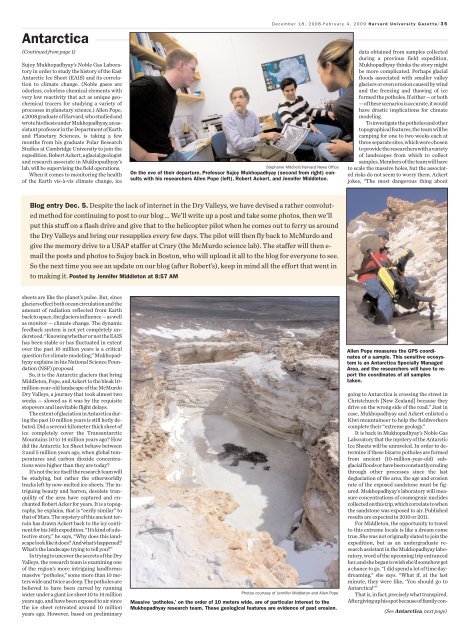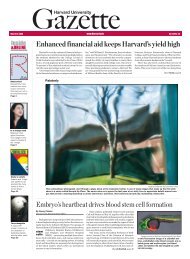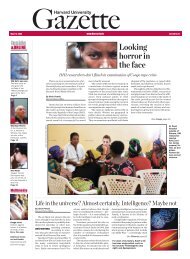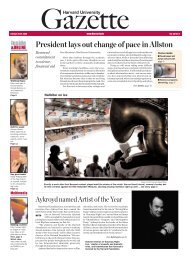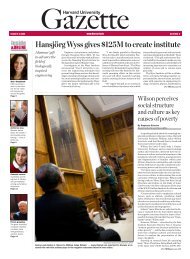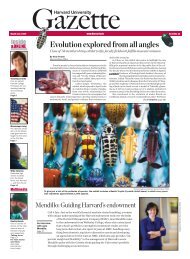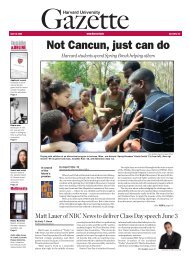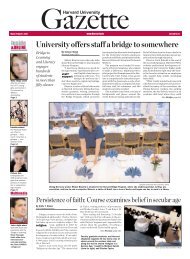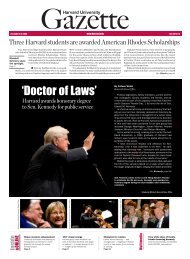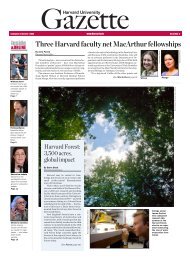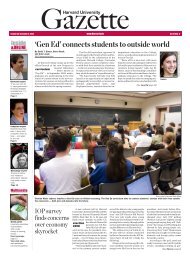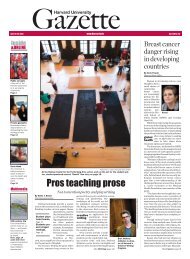Lawrence Lessig receives two Harvard appointments
Lawrence Lessig receives two Harvard appointments
Lawrence Lessig receives two Harvard appointments
- No tags were found...
Create successful ePaper yourself
Turn your PDF publications into a flip-book with our unique Google optimized e-Paper software.
Antarctica(Continued from page 1)Sujoy Mukhopadhyay’s Noble Gas Laboratoryin order to study the history of the EastAntarctic Ice Sheet (EAIS) and its correlationto climate change. (Noble gases areodorless, colorless chemical elements withvery low reactivity that act as unique geochemicaltracers for studying a variety ofprocesses in planetary science.) Allen Pope,a 2008 graduate of <strong>Harvard</strong>, who studied andwrote his thesis under Mukhopadhyay, an assistantprofessor in the Department of Earthand Planetary Sciences, is taking a fewmonths from his graduate Polar ResearchStudies at Cambridge University to join theexpedition. Robert Ackert, a glacial geologistand research associate in Mukhopadhyay’slab, will be supervising the field operations.When it comes to monitoring the healthof the Earth vis-à-vis climate change, iceStephanie Mitchell/<strong>Harvard</strong> News OfficeOn the eve of their departure, Professor Sujoy Mukhopadhyay (second from right) consultswith his researchers Allen Pope (left), Robert Ackert, and Jennifer Middleton.December 18, 2008-February 4, 2009 <strong>Harvard</strong> University Gazette/ 35data obtained from samples collectedduring a previous field expedition,Mukhopadhyay thinks the story mightbe more complicated. Perhaps glacialfloods associated with smaller valleyglaciers or even erosion caused by windand the freezing and thawing of iceformed the potholes. If either — or both—of these scenarios is accurate, it wouldhave drastic implications for climatemodeling.To investigate the potholes and othertopographical features, the team will becamping for one to <strong>two</strong> weeks each atthree separate sites, which were chosento provide the researchers with a varietyof landscapes from which to collectsamples. Members of the team will haveto scale the massive holes, but the associatedrisks do not seem to worry them. Ackertjokes, “The most dangerous thing aboutBlog entry Dec. 5. Despite the lack of internet in the Dry Valleys, we have devised a rather convolutedmethod for continuing to post to our blog ... We’ll write up a post and take some photos, then we’llput this stuff on a flash drive and give that to the helicopter pilot when he comes out to ferry us aroundthe Dry Valleys and bring our resupplies every few days. The pilot will then fly back to McMurdo andgive the memory drive to a USAP staffer at Crary (the McMurdo science lab). The staffer will then e-mail the posts and photos to Sujoy back in Boston, who will upload it all to the blog for everyone to see.So the next time you see an update on our blog (after Robert’s), keep in mind all the effort that went into making it. Posted by Jennifer Middleton at 8:57 AMsheets are like the planet’s pulse. But, sinceglaciers effect both ocean circulation and theamount of radiation reflected from Earthback to space, the glaciers influence — as wellas monitor — climate change. The dynamicfeedback system is not yet completely understood.“Knowing whether or not the EAIShas been stable or has fluctuated in extentover the past 10 million years is a criticalquestion for climate modeling,” Mukhopadhyayexplains in his National Science Foundation(NSF) proposal.So, it is the Antarctic glaciers that bringMiddleton, Pope, and Ackert to the bleak 10-million-year-old landscape of the McMurdoDry Valleys, a journey that took almost <strong>two</strong>weeks — slowed as it was by the requisitestopovers and inevitable flight delays.The extent of glaciation in Antarctica duringthe past 10 million years is still hotly debated.Did a several-kilometer thick sheet ofice completely cover the TransantarcticMountains 10 to 14 million years ago? Howdid the Antarctic Ice Sheet behave between3 and 5 million years ago, when global temperaturesand carbon dioxide concentrationswere higher than they are today?It’s not the ice itself the research team willbe studying, but rather the otherworldlytracks left by now-melted ice-sheets. The intriguingbeauty and barren, desolate tranquilityof the area have captured and enchantedRobert Acker for years. It is a topography,he explains, that is “eerily similar” tothat of Mars. The mystery of this ancient terrainhas drawn Ackert back to the icy continentfor his 14th expedition. “It’s kind of a detectivestory,” he says, “Why does this landscapelook likeit does? And what’shappened?What’s the landscape trying to tell you?”In trying to uncover the secrets of the DryValleys, the research team is examining oneof the region’s more intriguing landforms:massive “potholes,” some more than 10 meterswide and twice as deep. The potholes arebelieved to have been carved by runningwater under a giant ice sheet 10 to 14 millionyears ago, and have been exposed to air sincethe ice sheet retreated around 10 millionyears ago. However, based on preliminaryPhotos courtesy of Jennifer Middleton and Allen PopeMassive ‘potholes,’ on the order of 10 meters wide, are of particular interest to theMukhopadhyay research team. These geological features are evidence of past erosion.Allen Pope measures the GPS coordinatesof a sample. This sensitive ecosystemis an Antarctica Specially ManagedArea, and the researchers will have to reportthe coordinates of all samplestaken.going to Antarctica is crossing the street inChristchurch [New Zealand] because theydrive on the wrong side of the road.” Just incase, Mukhopadhyay and Ackert enlisted aKiwi mountaineer to help the fieldworkerscomplete their “extreme geology.”It is back in Mukhopadhyay’s Noble GasLaboratory that the mystery of the AntarcticIce Sheets will be unraveled. In order to determineif these bizarre potholes are formedfrom ancient (10-million-year-old) subglacialfloods or have been constantly erodingthrough other processes since the lastdeglaciation of the area, the age and erosionrate of the exposed sandstone must be figured.Mukhopadhyay’s laboratory will measureconcentrations of cosmogenic nuclidescollected on this trip,which correlate to whenthe sandstone was exposed to air. Publishedresults are expected in 2010 or 2011.For Middleton, the opportunity to travelto this extreme locale is like a dream cometrue. She was not originally slated to join theexpedition, but as an undergraduate researchassistant in the Mukhopadhyay laboratory,word of the upcoming trip entrancedher, and she began to wish she’d somehow geta chance to go. “I did spend a lot of time daydreaming,”she says. “What if, at the lastminute, they were like, ‘You should go toAntarctica!’”That is, in fact, precisely what transpired.After giving up his spotbecause of family con-(See Antarctica, next page)


